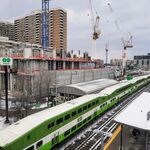Gardiner takedown study approved by executive committee
Toronto council's executive committee has voted in favour of restarting a shelved environmental assessment of the possible dismantling of an eastern portion of the Gardiner Expressway.
Coun. Mike Del Grande, the chair of the city's budget committee, introduced the motion Tuesday to take up the study into tearing down a stretch of the highway east of Jarvis Street. The original environmental assessment was abandoned in 2011.
"How much money do you spend on it without really analyzing or understanding whether it should stay up, should it stay down, should it be repaired, what should be done?" said Del Grande, who personally favours keeping the stretch of expressway intact.
"But to do nothing would be criminal."
The study would examine several options for the "takedown" of the Gardiner, a partially-elevated highway that was completed in 1965 and carries up to 200,000 vehicles per weekday. Staff estimate it would be six to nine years before dismantling can commence.
The executive committee voted in favour of the move to study options for the aging expressway amid heightened concerns about its safety and usability. A final vote in council is required before the study can be started.
City staff said as recently as December that the eastern portion of the expressway may not be fit for use within six years if repairs aren't carried out on the road surface.
Just keeping it operational in that time would cost at least $30 million to $35 million, not including additional millions for reinforcing the roadway. Moreover, the city has proposed spending an additional $505 million in repairs over the next 10 years to keep the Gardiner in good repair.
City staff have given increased scrutiny to the Gardiner in the wake of several incidents in which concrete fell from the structure and on to the roadway below.
Staff note provides new details on fate of study
The maintenance costs of the expressway contributed in part to the decision in July 2008 by the administration of former Mayor David Miller to start the environmental assessment.
But top bureaucrats from the city and Waterfront Toronto decided to put a hold on the assessment in Nov. 2010 after Mayor Rob Ford was elected "pending direction from the new council and administration," according to a staff briefing note released Tuesday.
Current public works and infrastructure committee chair Denzil Minnan-Wong then asked staff in March 2011 for a letter for him to introduce in committee to request a report on the effects of modifying the terms of the environmental assessment.
But when he was given the letter, he never tabled it, the briefing note said.
Sometime that year, $4.41 million in unused funds of the $7.69 million study was dedicated to other projects by Waterfront Toronto.




